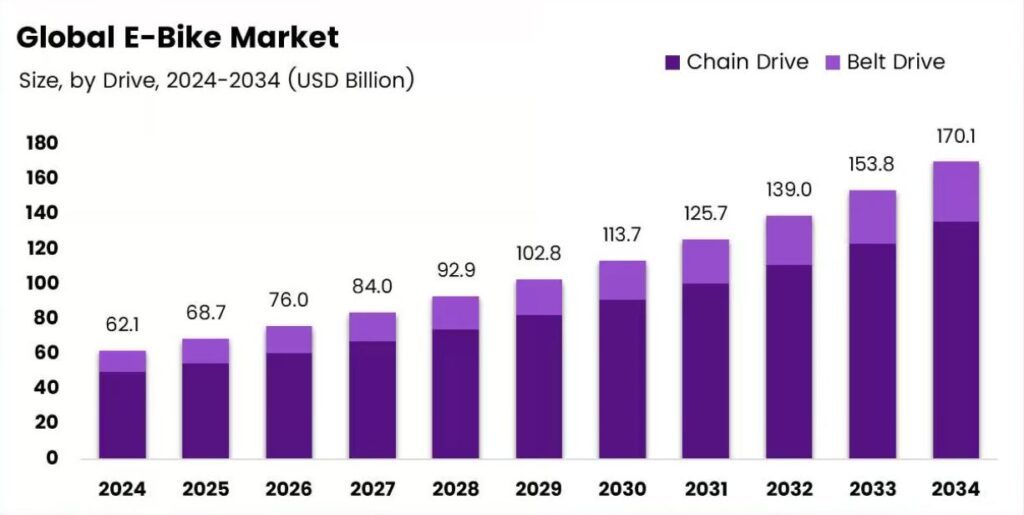Opportunities and Strategies
The e-bike industry is experiencing a transformative surge, driven by urbanization, environmental awareness, and technological advancements. For small businesses, e-bike market trends for small businesses in 2025 present significant opportunities to tap into a rapidly growing market valued at USD 38.08 billion globally in 2025, with a projected compound annual growth rate (CAGR) of 7.98% through 2029. From retail and rentals to delivery services and manufacturing, small businesses are finding innovative ways to capitalize on the e-bike boom. This article explores the key e-bike market trends for small businesses in 2025, offering insights into opportunities, challenges, and strategies to thrive in this dynamic sector.
The E-Bike Market Boom in 2025
The global e-bike market is thriving, fueled by a shift toward sustainable transportation and supportive government policies. In the U.S. alone, the market is expected to reach USD 4.06 billion in 2025, with over 700,000 units sold annually., Small businesses, from bike shops to logistics startups, are uniquely positioned to leverage e-bike market trends for small businesses in 2025 due to their agility and ability to cater to niche markets.

Why E-Bikes Are a Game-Changer for Small Businesses
E-bikes offer a versatile, eco-friendly, and cost-effective solution for urban mobility, making them attractive for both consumers and businesses. Their ability to navigate congested city streets, reduce carbon footprints, and lower operating costs compared to gas-powered vehicles makes them ideal for small businesses in retail, rentals, and last-mile delivery. The growing popularity of e-bikes for commuting, recreation, and logistics is driving demand, creating new revenue streams for entrepreneurs.
Key Drivers of Market Growth
Several factors are propelling e-bike market trends for small businesses in 2025:
-
Urbanization and Traffic Congestion: With 56% of the global population living in urban areas, e-bikes provide a practical alternative to cars, especially in densely populated cities like New York and London.
-
Environmental Awareness: Consumers and businesses are increasingly prioritizing sustainability, with e-bikes offering zero-emission transport.
-
Government Incentives: Subsidies, tax breaks, and infrastructure investments, such as the USD 862 million cycling infrastructure commitment in the Netherlands, are boosting e-bike adoption.
-
Technological Advancements: Innovations in lithium-ion batteries, lightweight materials, and smart connectivity are enhancing e-bike performance and appeal.
Key E-Bike Market Trends for Small Businesses in 2025
Small businesses can capitalize on several emerging e-bike market trends for small businesses in 2025, each offering unique opportunities to innovate and grow.
Surge in Cargo E-Bike Adoption
Cargo e-bikes are one of the fastest-growing segments, particularly for small businesses in urban logistics. With a projected CAGR of over 15% in North America, cargo e-bikes are ideal for last-mile delivery, offering a greener and cheaper alternative to vans. Small businesses like cafes, florists, and courier services are adopting cargo e-bikes to navigate tight urban spaces and meet sustainability goals. For example, companies like Zoomo provide subscription-based cargo e-bikes tailored for delivery businesses, with features like large storage and extended battery range.
Opportunities for Small Businesses
-
Delivery Services: Small businesses can launch or expand last-mile delivery operations, leveraging cargo e Judd-ikes to reduce fuel costs and meet eco-conscious consumer demands.
-
Retail and Rentals: Selling or renting cargo e-bikes to other small businesses, such as food delivery startups, can tap into this growing niche.
Rise of Subscription-Based Models
Subscription-based e-bike services are gaining traction, offering small businesses a low-risk way to enter the market. Companies like Swapfiets and Forest are pioneering flexible leasing models, with plans starting at $49 per week, including maintenance and insurance. These models appeal to small businesses that want to offer e-bikes to employees or customers without the high upfront costs of ownership.
Opportunities for Small Businesses
-
Fleet Management: Small businesses can partner with subscription providers to offer e-bikes for employee commuting or customer rentals, creating new revenue streams.
-
Service Providers: Entrepreneurs can start maintenance or repair services for subscription fleets, addressing the growing need for aftermarket support.
Growth in E-Commerce and Click-and-Collect
E-commerce is reshaping the e-bike market, with online sales growing by 60% year-over-year in 2024. The “click-and-collect” model, where customers buy online and pick up at local stores, is particularly popular, with 2% of e-bike sales in independent bike dealers (IBDs) occurring online but driving foot traffic to physical stores. This trend benefits small businesses with both online and brick-and-mortar presence.
Opportunities for Small Businesses
-
Online Retail: Small bike shops can expand their reach by selling e-bikes through e-commerce platforms, offering click-and-collect to blend online convenience with in-store support.
-
Marketing and Branding: Leveraging social media and local partnerships to promote e-bikes can attract eco-conscious consumers and boost sales.
Technological Advancements
Innovations in battery and motor technology are enhancing e-bike performance, making them more appealing to small businesses. Lithium-ion batteries, which hold 99% of the market share, offer longer ranges and faster charging, while mid-drive motors provide better torque for cargo and mountain e-bikes. Smart features like GPS tracking and app-based diagnostics are also becoming standard, improving reliability and user experience.
Opportunities for Small Businesses
-
Specialized Retail: Small businesses can focus on selling high-tech e-bikes, such as Segway’s Xafari and Xyber, which feature smart connectivity and long-range capabilities.
-
Custom Builds: Offering customized e-bikes with modular components or IoT-enabled systems can cater to niche markets like adventure tourism or urban commuting.
Focus on Niche Markets
The diversification of e-bike models is creating opportunities for small businesses to target specific demographics, such as seniors, families, or adventure enthusiasts. Folding e-bikes, like Yadea’s UFO S, cater to urban dwellers with limited storage, while e-MTBs (electric mountain bikes) are driving demand among recreational riders, with the global e-MTB market projected to reach USD 13.88 billion by 2030.,
Opportunities for Small Businesses
-
Niche Retail: Small businesses can specialize in e-bikes for specific groups, such as foldable models for apartment dwellers or e-MTBs for outdoor enthusiasts.
-
Tourism and Rentals: Offering e-bike rentals for tourists in scenic areas, like coastal routes or national parks, can capitalize on the growing adventure tourism trend.
Challenges for Small Businesses
While e-bike market trends for small businesses in 2025 offer significant opportunities, challenges remain that require strategic planning.
Regulatory Inconsistencies
E-bike regulations vary widely across regions, creating compliance challenges for small businesses. For example, Class 1 e-bikes (pedal-assist, 20 mph max) face fewer restrictions than Class 3 e-bikes (28 mph max), which may require licensing in some U.S. states. Inconsistent rules can complicate sales, rentals, and fleet operations for small businesses expanding across borders.
Strategies to Overcome
-
Stay informed about local regulations through resources like PeopleForBikes.
-
Partner with legal consultants to ensure compliance when operating in multiple regions.
Supply Chain Disruptions
Supply chain issues, particularly for semiconductors and lithium, can delay e-bike production and increase costs. Small businesses with limited resources may struggle to secure inventory, especially for high-demand models like cargo e-bikes.
Strategies to Overcome
-
Build relationships with multiple suppliers to diversify sourcing.
-
Focus on second-hand or refurbished e-bikes, which are gaining popularity as cost-effective alternatives.
High Initial Costs
While subscription models reduce upfront costs, purchasing e-bikes for retail or rental fleets can be expensive. Small businesses may face financial strain, especially with rising tariffs on Chinese imports potentially increasing prices in 2025.
Strategies to Overcome
-
Explore lease-to-own or financing options for inventory purchases.
-
Leverage government subsidies or grants for sustainable transport businesses, such as those offered in Alameda, California (up to USD 600 rebates).
Strategies for Small Businesses to Thrive
To capitalize on e-bike market trends for small businesses in 2025, entrepreneurs can adopt the following strategies:
Invest in Local Partnerships
Collaborating with local governments, urban planners, and cycling organizations can enhance market access. For example, partnering with cities like Portland, Oregon, which boasts extensive bike lanes, can promote e-bike adoption and secure incentives. Small businesses can also work with advocacy groups like the League of American Bicyclists to promote e-bike-friendly policies.
Embrace Digital Transformation
Investing in e-commerce platforms and digital marketing is crucial. Small businesses can use social media to showcase customer testimonials, like those from delivery drivers who praise e-bikes for efficiency, to build trust. Offering click-and-collect services can drive foot traffic to physical stores while catering to online shoppers.
Focus on Sustainability
Highlighting the eco-friendly benefits of e-bikes can attract environmentally conscious customers. Small businesses can market their commitment to sustainability, such as using recyclable packaging or partnering with battery recycling programs, to differentiate themselves in a competitive market.
Offer Tailored Services
Providing value-added services, such as maintenance, customization, or guided e-bike tours, can set small businesses apart. For example, Pedego’s New Jersey store offers rentals and access to scenic trails, enhancing the customer experience.
Case Studies: Small Businesses Succeeding in 2025
Pedego Electric Bikes (New Jersey)
Pedego’s Marlboro store, opened in 2022, exemplifies how small businesses can thrive by combining retail, rentals, and community engagement. By offering e-bike rentals and direct access to the Henry Hudson Trail, the store caters to both locals and tourists, capitalizing on the recreational cycling trend.
Zoomo (Global)
Zoomo, a subscription-based e-bike provider, supports small delivery businesses by offering cargo e-bikes with GPS tracking and maintenance services. Its flexible plans, starting at £45 per week, enable small businesses to scale operations without significant capital investment, aligning with e-bike market trends for small businesses in 2025.
Future Outlook for 2025 and Beyond
The e-bike market is poised for continued growth, with projections estimating a global value of USD 170.1 billion by 2034. Small businesses can expect increased demand for cargo e-bikes, subscription services, and smart e-bikes with IoT features. Investments in battery recycling and lightweight materials will further drive sustainability, while cities like Minneapolis and Amsterdam continue to expand bike-friendly infrastructure.
Conclusion
E-bike market trends for small businesses in 2025 highlight a wealth of opportunities, from cargo
to e-commerce and niche markets. By leveraging technological advancements, government incentives, and consumer demand for sustainable transport, small businesses can carve out a profitable niche in this booming industry. Despite challenges like regulatory inconsistencies and supply chain disruptions, strategic partnerships, digital transformation, and a focus on sustainability can ensure long-term success. For more insights into market forecasts, visit Mordor Intelligence, or stay updated on regulatory and industry changes at PeopleForBikes, a leading advocacy and resource hub for cycling businesses.



